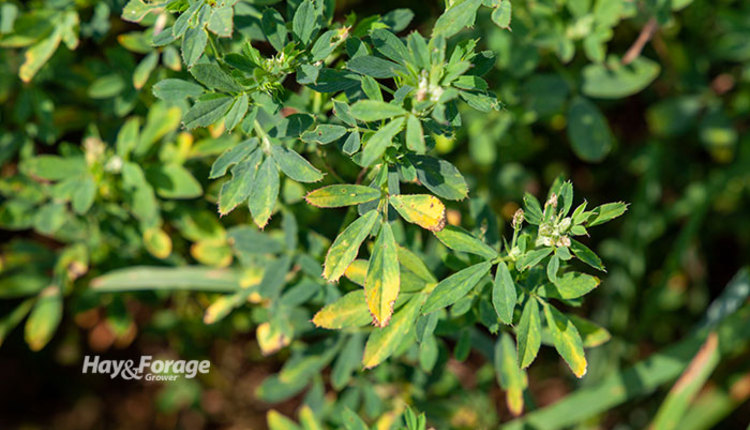
Potato leafhoppers have maintained a low profile so far this year, but they may soon make their presence known. These insects are considered one of the most damaging pests of alfalfa and scouting potato leafhoppers is essential to limit economic losses.
A recent article from Penn State Extension’s Field Crop News newsletter explains that potato leafhopper infestations may occur later this year due to a lack of rainfall in the Midwest. These insects overwinter in areas along the Gulf of Mexico and typically move north with storm systems during the spring. Despite the delay in migration, potato leafhoppers can still cause significant injury to alfalfa this season.
Insect life cycle
Once potato leafhoppers arrive in a field, adult females lay their eggs in alfalfa stems and leaf veins. When the eggs hatch, nymphs can mature in as little as three weeks. Adult potato leafhoppers are pale green, wedge-shaped, and approximately 1/8 inch long.
Nymphs and adults feed on alfalfa by using their sucking mouthparts to extract plant sap. This process inhibits nutrient transport in plants, which leads to reduced forage yield and quality. The feeding process also results in leaf chlorosis known as hopperburn. Leaves will develop yellow triangles at the leaf tip and damage will spread toward the base of the leaflet as insect feeding worsens.
Hopperburn does not appear on plants until seven to 10 days after potato leafhoppers begin feeding, and at this point, economic loss has likely already occurred. In addition to the number of potato leafhoppers present, the economic injury threshold of an alfalfa stand depends on plant height, crop value, and the cost of insecticide.
Damage control
Using a sweep net is the best way to estimate potato leafhopper populations. To take a sample, make 20 pendulum swings of a sweep net while following a zigzag pattern through part of an alfalfa field. Take one or two steps in between each swing.
After making 20 pendulum swings, continue swinging the sweep net to force potato leafhoppers together and grab the end of the net to trap insects there. Slowly open the sweep net and count green potato leafhoppers as they fly away, but do not count brown ones. Also, check the inside of the sweep net for nymphs as insects in this life stage do not have wings.
Repeat these steps in four other parts of the field, creating a U-shape out of the sampling sites. Add up the number of potato leafhoppers collected among the five samples and divide the total number of insects by 100.

The shorter alfalfa is, the smaller the potato leafhopper population will be to warrant chemical control. In fact, the greatest crop losses occur when plants are less than 6 inches tall, whereas plants that are at least 12 inches tall can tolerate heavier feeding pressure.
Furthermore, a high-value crop will have a lower economic injury threshold. For example, it is more profitable to spray alfalfa valued at $240 per ton than to spray alfalfa valued at $120 per ton with an equal potato leafhopper population. That said, the profitability of chemical control declines as insecticide prices rise.
One way to limit potato leafhopper damage without insecticide is to harvest alfalfa early; however, plant regrowth may still be subject to infestation. Other methods of prevention include planting resistant varieties of alfalfa, which have fine hairs called glandular trichomes on plant stems to discourage potato leafhoppers from feeding. Mixed alfalfa-grass stands have also been shown to incur less damage from potato leafhoppers than pure alfalfa stands.

